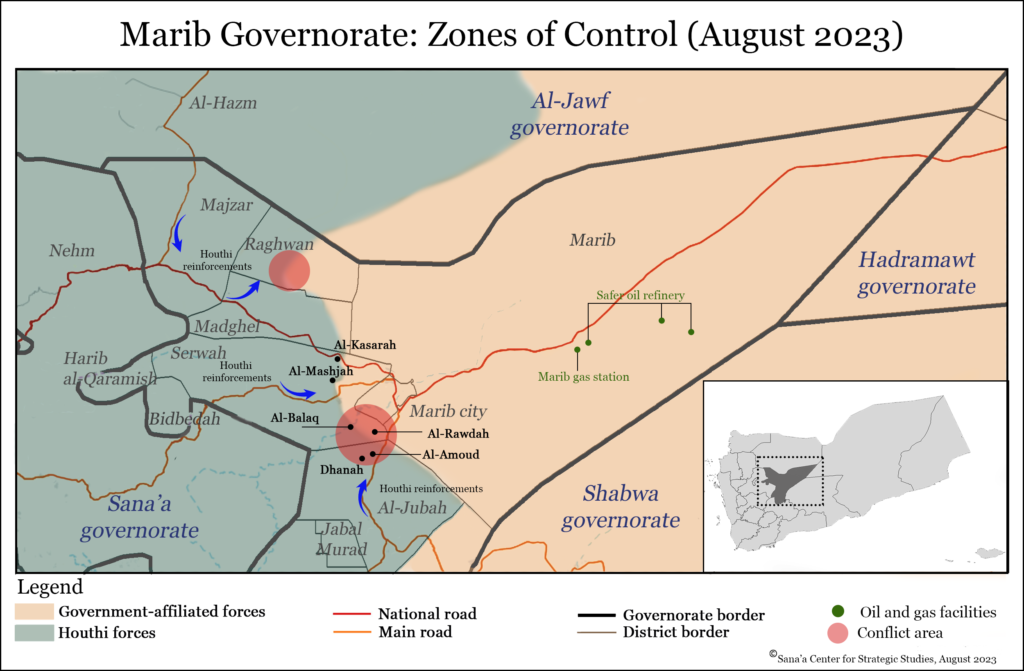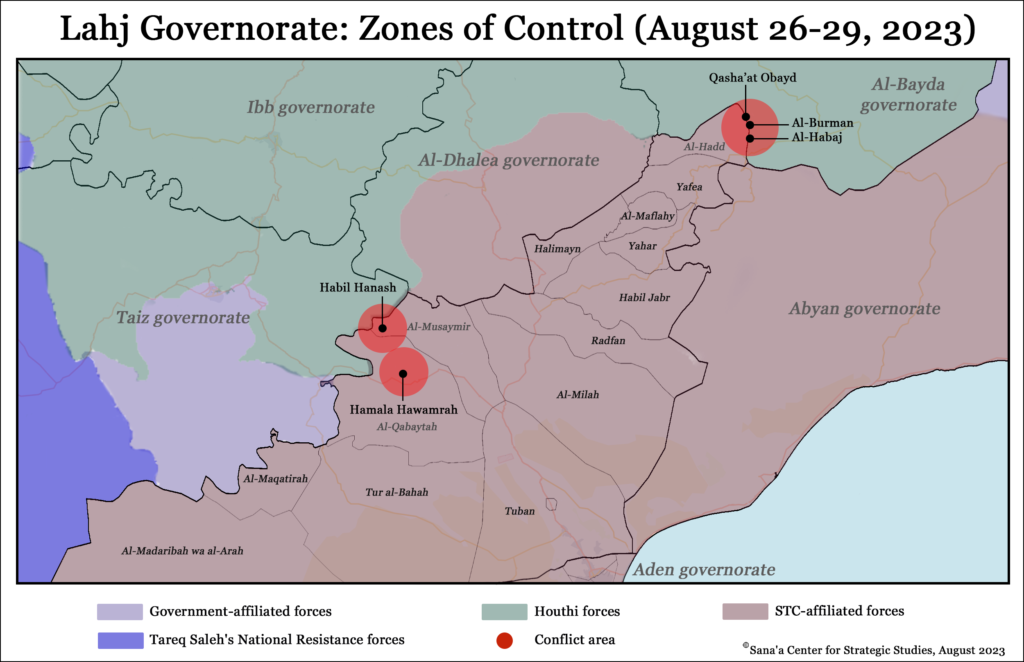Tensions rose in Marib as Houthi forces continued to send reinforcements to the governorate and clashes broke out on several fronts. A series of Houthi military tests and maneuvers provided some insight into the scale of mobilization that has happened over recent months. During the first week of August, foreign munitions experts were reported attending Houthi weapons testing in the Habab Valley in western Serwah district. The demonstration apparently went awry, causing a series of explosions that reportedly killed several Houthi military commanders and foreign experts, likely Iranian, in attendance. On August 7, Houthi military maneuvers were held near the border of Sana’a’s Nehm district and Marib’s Majzar district, complete with a display of paratroopers jumping from a helicopter.
In mid-August, Houthi forces began to bolster their frontlines around Marib city, sending reinforcements to the Al-Kasarah front to the northwest on August 14, and mobilized additional reinforcements, including soldiers, armored vehicles, radar jammers, and missiles, to the Dhanah and Al-Amoud areas along the Al-Rawdah front, southwest of Marib city, on August 15. The following day, another group of reinforcements arrived in the Al-Balaq and Al-Mashjah areas west of Marib city, and on August 17, Houthi soldiers from Al-Jawf fortified positions in Raghwan district in northwestern Marib.
Clashes were reported concurrently on several fronts, as Houthi forces attempted to capitalize on the de facto truce, much to the chagrin of UN Special Envoy to Yemen Hans Grundberg. Reports indicate that fighting was focused in Serwah and Raghwan districts. The Al-Rawdah front, which extends from the Al-Balaq mountains in the east of Serwah district to the north of Al-Jubah district, was particularly active, with clashes reported on August 14, 17, 24, and 25. Much of the fighting was focused near the Al-Balaq area, which also experienced intermittent shelling and Houthi drone flyovers from August 28-31, according to a community activist. Fighting between Houthi and pro-government forces also picked up in Raghwan district later in the month, with clashes on August 17 and 24, according to a community activist.
In late August, Marib saw a spike in political activity as well, with the return of PLC member and Marib Governor Sultan al-Aradah from Saudi Arabia for the first time in nearly a year. Al-Aradah quickly got to work, meeting with UN Special Envoy Grundberg on his first visit to Marib on August 30.
New Counterterrorism Campaign Targets Al-Qaeda in Abyan
Counterterrorism forces in Abyan’s Mudiya district gained momentum with the formation of Operation Swords of Haws, a new campaign to complement the ongoing Operation Arrows of the East. The campaign, which is comprised of STC-affiliated Security Belt forces, Abyan Military Axis forces, Support and Backup Brigades, and local Abyan security and pro-government forces, is named in honor of the late commander of popular resistance forces in Lawder, Tawfiq al-Junaidi (nicknamed Haws), who was killed in an Al-Qaeda bombing in 2011.
Since the announcement of its formation on August 6, the campaign has reported several successes as it focused on securing the Rafd and Jenin Valleys in northern Mudiya district. Among its major accomplishments were the arrest of Al-Qaeda military commander Saeed Ali Saeed al-Anbouri (Abu Al-Qaqaa) in the Al-Habaj area of Mudiya on August 6, the securing of the Rafd and Jenin Valleys on August 20, and the discovery of a clandestine Al-Qaeda base in Jenin Valley on August 27, according to Security-Belt affiliated sources. The forces are now working to secure the mountain and valley regions of Mudiya, where Al-Qaeda members are difficult to flush out, and tightening their control over the Al-Hanaka area near the border with Shabwa’s Hateeb district.
Al-Qaeda militants fought back, raiding Swords of Haws positions several times throughout the month. On August 10, an Al-Qaeda landmine killed Abdellatif al-Sayed, who was appointed overall commander of the STC-aligned Security Belt forces in Abyan earlier in the month, along with three other soldiers, according to a Security Belt-affiliated military source. Experts and intelligence sources believe the killing may have been an inside job, and that Al-Sayed’s location and movements had been betrayed to Al-Qaeda, as the commander was famously cautious when it came to revealing his location and movements.
International Employees Targeted
A government investigation has linked the killing of Moayad Hameidi, the World Food Programme employee who was killed in Al-Turbah city last month to Al-Qaeda in the Arabian Peninsula (AQAP). Information from security and jihadi sources suggests that the assassination of Hameidi is reportedly part of a grander scheme to target employees of international organizations. On August 15, unidentified gunmen assassinated an officer of the Taiz Political Security department who was part of the team investigating Hameidi’s death, after sending him death threats demanding he stop the investigation. A week later, a local Al-Qaeda affiliate released a statement condemning raids that came as part of the post-assassination security crackdown in Taiz, threatening that continued security efforts would provoke more violence.
Al-Qaeda leaders appear to be sticking to their new strategy, as several other attempted attacks were linked to the group this month. According to security sources, a car bomb discovered in Taiz governorate was believed to belong to Al-Qaeda and was intended for a similar assassination operation. In Aden, UN and security sources reported that the headquarters of two international organizations were recently attacked with RPGs. On August 28, two Doctors Without Borders (MSF) employees, one German and a Myanmar national, were reportedly kidnapped by unknown gunmen in Marib as they were traveling from Seyoun city in Hadramawt without a security escort. No group has yet to claim responsibility for the abduction.
On a brighter note, five UN employees, four Yemenis and one Bangladeshi, who were kidnapped by Al-Qaeda in Abyan, were released on August 11, after being held captive for more than 18 months. According to anonymous security and tribal officials, the group’s release was a lengthy process that involved officials from Oman, in which a ransom was eventually paid to Al-Qaeda militants – a claim disputed by the UN.
Al-Bayda-Lahj Borderlands Heat Up
Regular frontline fighting between Houthi forces and the STC-affiliated 4th Support and Backup Brigade rose significantly this month in the area straddling Al-Bayda’s Al-Zahir district and Lahj’s Al-Hadd and Yafea districts. The Al-Burman and Al-Habaj areas saw heavy casualties, but fighting climaxed in the Qasha’at Obayd area in the east of Al-Hadd district on August 26-27 with an uncharacteristically large Houthi assault on this front that killed and wounded dozens of fighters on both sides. While online casualty reports vary drastically, local sources report that across the various fronts in the border region, at least 13 STC-affiliated soldiers were killed and 26 were wounded throughout the month, while at least 22 Houthi fighters were killed and 28 wounded.
To the north, the border between Al-Bayda’s Naaman district and Shabwa’s Bayhan district also witnessed an uptick in fighting, with Houthi forces clashing with STC-affiliated Shabwa Defense forces and UAE-backed Giants Brigades for the first time along the Aqbat Adma front on August 8, according to eyewitness reports. Fighting also resumed on the Aqbat al-Qantha front on August 6 and 28, which had been dormant since March.
Houthis Clash with Al-Jawf Tribes
Houthi forces arrested a number of tribesmen in three districts of Al-Jawf along the governorate’s border with Marib. The Houthis have besieged villages of the Bani Nawf tribes since mid-July, following the killing of a prominent Houthi commander in the area. At the same time, Houthi forces have besieged villages along Al-Jawf’s border with Sa’ada, in an attempt to exploit a tribal land dispute and expand their control in the area. In response, tribal leaders from across Al-Jawf have convened meetings in government-controlled areas in and around the governorate, calling on tribes to settle their internal disputes and unite against the Houthis. But a large number of tribal sheikhs have also completed a Houthi cultural indoctrination course in Sana’a and met the president of the Supreme Political Council, Mahdi al-Mashat. The tribal leaders signed a document pledging to fight outlaws and drug dealers in Al-Jawf, where the Houthi-run Ministry of Interior has deployed additional forces under the pretext of combating crime and smuggling, but coinciding with a siege of Bani Nawf tribal areas.


